Half-orphaned and “Boarded out”
… a review of the early life and times of Mattie Maria Cook (1883-1918).
One of the unexpected bonuses I’ve encountered in researching family history is making connections with unknown distant relatives. Since starting this project I have been able to make connections with distant cousins in three of the four main lines of my mother’s family (Hinkson, Northcutt & Cook) that have yielded lots of new insights and research leads.
As I begin to craft this chapter on my paternal great-grandmother Mattie Maria Cook (1883-1918) I must give a huge shoutout to a recently discovered distant cousin, Susan McGuire Cooksey. Without Susan’s research and willingness to share old family photos and insights that had been passed down to her by her grandmother Almeda (Mattie’s sister) I would have had little to write about. Thank you, Susan. I’m so glad to have connected with you.
Mattie Maria Cook was just 7 years old when her mother, Sarah Elizabeth Thornton Cook (1850-1890), died on Dec 28, 1890, just three days after Christmas. She was 40 years old when she passed, leaving behind five children under the age of 14. Mattie’s father, Henry Albert Cook (1850-1890), was an ambitious farmer and businessman, but he was also realistic. With five sets of smaller feet underfoot, he wasted no time in searching for another woman to help raise his children. Within a month of Sarah’s passing (and possibly to support his search) Henry shaved off his beard and took the children into the nearby town of Croswell to have their picture taken at the local photography studio.
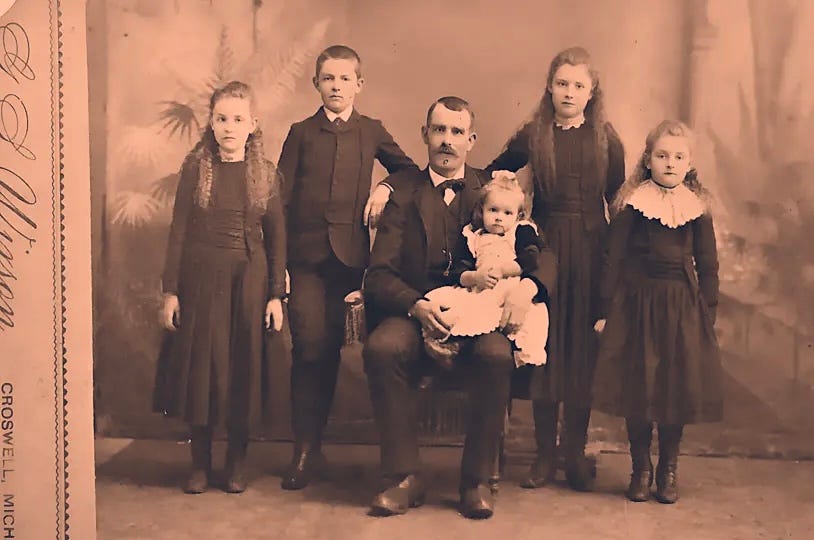
Pictured left to right are Albertha Nancy (1880-1961), John Percival (1876-1965), Henry Albert Cook (1850-1907), Mae Belle, on Henry’s lap (1888-1956), Almeda Elizabeth (1878-1966) and Mattie Maria (1883-1918).
When I first saw this photo of Henry and his five children, I was really struck by how awkward it looked to me. I wondered why Henry chose to have the photo taken in the first place. Was the photo intended to be a keepsake that documented the children’s ages and physical appearances when his wife died and his children half-orphaned? Or, was it intended for another reason? Perhaps to help support Henry’s search for a new caregiver. Regardless of which, the children appear shell-shocked to me with little emotion on their faces. I may be reading too much into it. Given the circumstances of when the photo was taken, it seems as if you can just read the children’s faces and the thoughts that must be swirling around in their collective heads:
“I can’t believe Pa made us dress up in our Sunday best and forced us to have this photo taken… I refuse to look happy about this… Why did Ma have to die?… I hate my life… Can’t we just go home… I really miss Ma…. I just want my mother back!”
I’ve looked at this photo multiple times since Susan first shared it. Every time I do, I think Henry’s motivation for having the awkward family photo taken was perhaps the latter. In my mind, I envision Henry posting the photo to the “community board” at his dry goods store with the solicitation “Wanted: A live-in caretaker. Contact Henry Cook.” All in the hopes that some eligible woman might look at the photo and think that “looks like a clean-cut family man with five well-dressed, good-looking children - what more could a [single woman, spinster, or widow] want in life in exchange for a roof overhead and comfortable house to manage.”
Before I jump further into this story and share more about the family’s journey after Sarah Thornton Cook passed away, I’d like to backtrack a bit and provide more info about my great-grandmother, Mattie, and her parents.
Mattie Maria Cook was born February 2, 1883, in Oscoda, in northern Michigan near the shores of Lake Huron. She was the fourth child (third daughter) born to Henry Albert Cook (1850-1907) and Sarah Elizabeth Thorton (1850-1890). Both her parents had been born in the Canadian providence of Ontario and had separately relocated with their families to Sanilac County in Michigan during the 1860s to escape economic hardships in Canada.
Both the Cook and Thornton families, headed by Henry H. Cook and John James Thornton, respectively, settled in the Washington township area of Sanilac County. These images from a 1876 land ownership map created by F.W. Beers & Company (accessible through the Library of Congress) show the location of J.J. Thornton’s (Sarah Elizabeth’s father) eighty acres as well as the Cook family land, owned and farmed by Henry H. Cook (80 acres) and his sons:
Henry Albert Cook (80 acres) - My 2x great-grandfather
Milner Charles Cook (80 acres)
John Cook (40 acres)
William Nicholas Cook (40 acres)
Thomas Cook (20 acres).
It’s interesting to see how close the two families lived in relation to each other. Click on each image to enlarge.
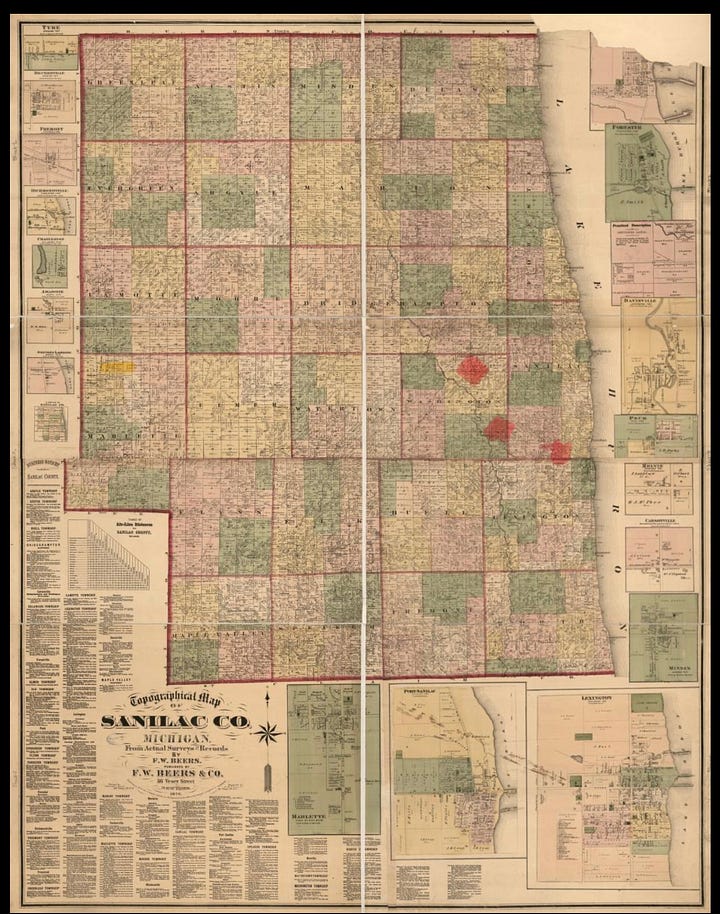
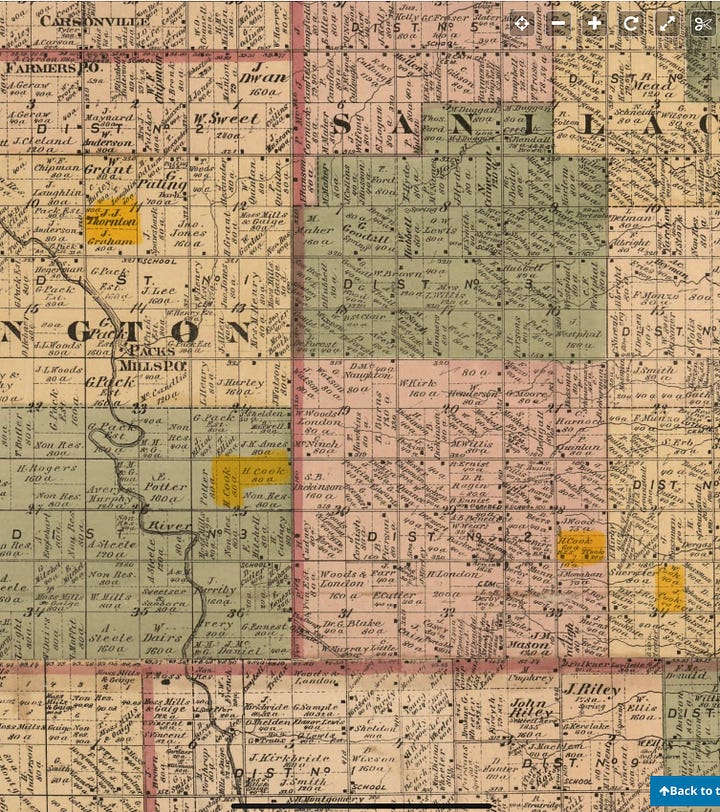
Henry and Sarah Elizabeth Thornton were married in Lexington, MI on April 15, 1875 and settled in Sanilac County, which is found in the geographic area of Michigan best described as the ‘thumb’ on the “Michigan mitten”. The marriage was witnessed by Sarah’s brother, John Wade Thornton, and Henry’s sister, Maria Eleanor Cook. The ceremony was performed by Rev. William Taylor of the Methodist Episcopal Church.
I found it interesting that Henry and Sarah each had a sibling of the opposite sex who served as a witness to their marriage. So I investigated it more and found that my suspicions were correct. Henry’s sister and Sarah’s brother were also a couple. The two witnesses, John and Maria, got married not much longer after Henry and Sarah did. Both Henry and Sarah were 25 when they married.

Shortly after Sarah’s death, Henry employed Eliza Jane Hymers Kipp as a housekeeper and caregiver. Eliza was a widow, who had a history of being a caregiver for other families. In her younger years, she had been employed as a caregiver for the children of Hamilton Kipp (a widower himself) and later married him and added five more children to the Kipp family. In less than a year after Sarah’s death, Eliza also advanced from being an employee of the Cook family to being Henry’s wife.
When Henry married Eliza Kipp on December 19, 1891, she brought with her at least one step and several biological children from her previous marriage. With the Cook and Kipp families combined, the house was overflowing with at least nine children under the roof.
I’m sure this adjustment was very difficult for the five Cook children. Their mother had been gone less than a year and already their father had remarried, bringing not just a new matriarch into the family, but more competition for parental attention. Within five years of the marriage Eliza would give birth to two more children, further expanding the Cook/Kipp household.
In the spring of 1891, it appears that Henry bought two lots in the town of Croswell and built a new home for the family. A year later he sold the home and extra lot and used the proceeds to explore business ownership.
I suspect with a new wife and six additional children to support, Henry figured he needed a better way to make a living beyond farming. In March 1892 Henry bought a grocery and dry goods store and grain elevator from D. Quail in the growing community of Valley Centre, MI as part of the settlement of his late wife’s estate. The account of this transaction, as well as the 1891 purchase of the initial Croswell lots, is captured in the probate court document below. It outlines both the purchase and sale of Croswell lots as well as the purchase of a store in Valley Centre.

The new business venture appeared to be a successful one for Henry and the Cook family. I imagine that Mattie along with her siblings, and step-siblings, helped out frequently with shelf restocking and store upkeep. Weekly ads promoting sales and new merchandise were frequently printed in the local newspaper.
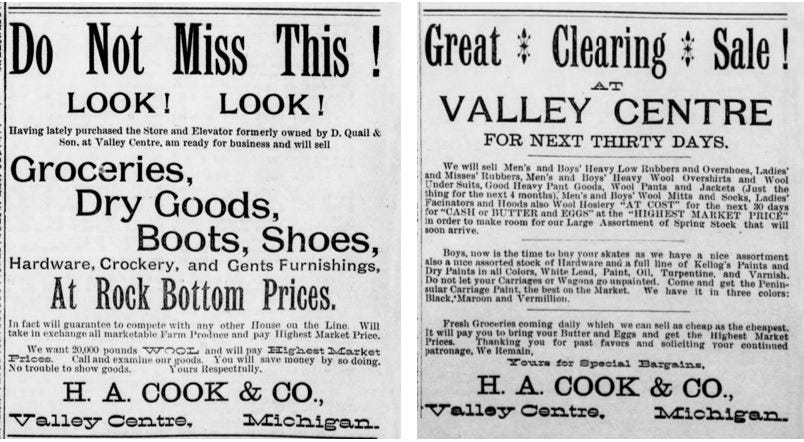
By all accounts, H.A. Cook’s dry goods and grocery business was doing very well. In fact, business around Valley Centre was doing so well in 1892 that Henry aspired to make the Valley Centre business district even larger. In August 1892, Henry ran these two business ads in the Detroit Free Press trying to entice other entrepreneurs to become his business partner or establish other businesses of their own in Valley Centre.
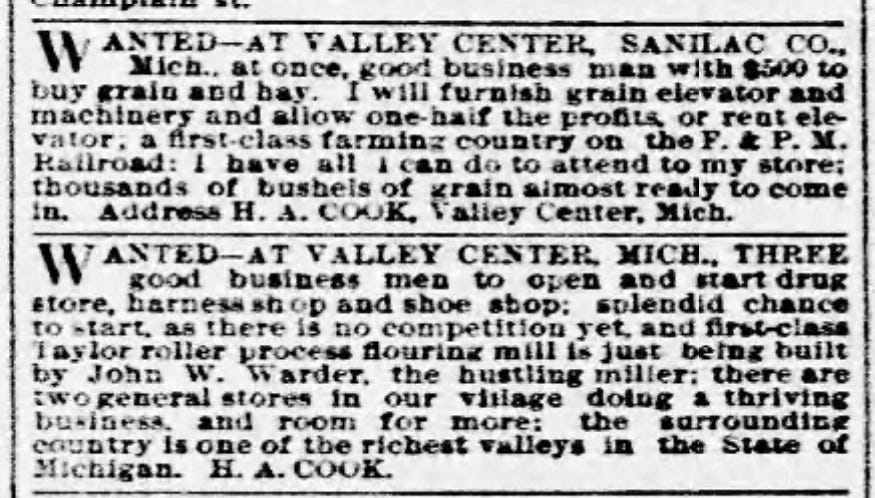
I’m unsure if either business ad produced any actual inquiries or results. But by August 1893, Henry’s outlook on the future of his ‘Valley Centre empire’ had changed dramatically when his store was badly damaged by fire.
While it was reported that insurance would cover most of the damage, Henry saw this as an opportunity to pursue larger land ownership in the soon-to-be-opened area of the Oklahoma Territory (O.T.).
In September 1893, just one month after the fire, Henry traveled to the newly established tent city of Enid, O.T. to participate in the land run for the “Cherokee Outlet.” From the newspaper accounts, it seems that the five Cook children moved to Enid with Henry several months before Eliza Hymers Cook made the trip with the three other children. At the of the publication of this news item, Allie Cook would have been two years old. He was the first of the two children born to Eliza and Henry.
The fact that Henry and the children he had fathered with Sarah Thornton had traveled out to Enid many months before Eliza followed with hers, makes me believe that there may been some tension or distance within the family. From my brief exchange with a distant cousin, I learned that the Cook children unfortunately did not get along well with their stepmother. Under the circumstances of the close proximity of their mother’s death to Henry and Eliza’s marriage, this might be understandable and perhaps, unavoidable.
Life in Enid settled down as Henry began to work his homesteading claim with his family’s assistance. His claim was about 5 miles south of Enid. According to a distant cousin, the family lived in a rough dugout for a few mi thx while the family home was being built..
In researching his claim with the Bureau of Land Management, I discovered that his homestead of 160 acres now resides just a mile south of Vance Air Force Base and borders interstate I85. The issue date of the land record is Feb 2, 1900, which tells me that Henry chose to homestead the land for the 5 years required by the Homestead Act, instead of opting for the alternative purchase option at $1.25 per acre. Here is the description of Henry’s claim from the Bureau of Land Management records and a screenshot of the location:
The northeast quarter of Section 12 in Township twenty-one North of Range Seven West of Indian Meridian in Oklahoma, containing one hundred and sixty acres.

In looking at location of Henry’s original claim, it appears the land is still farmed. There is a home on the property, but it’s obscured from street view on Google maps, so I can’t tell if any of it is the original home is still standing. Perhaps one day I’ll be able to check it out.
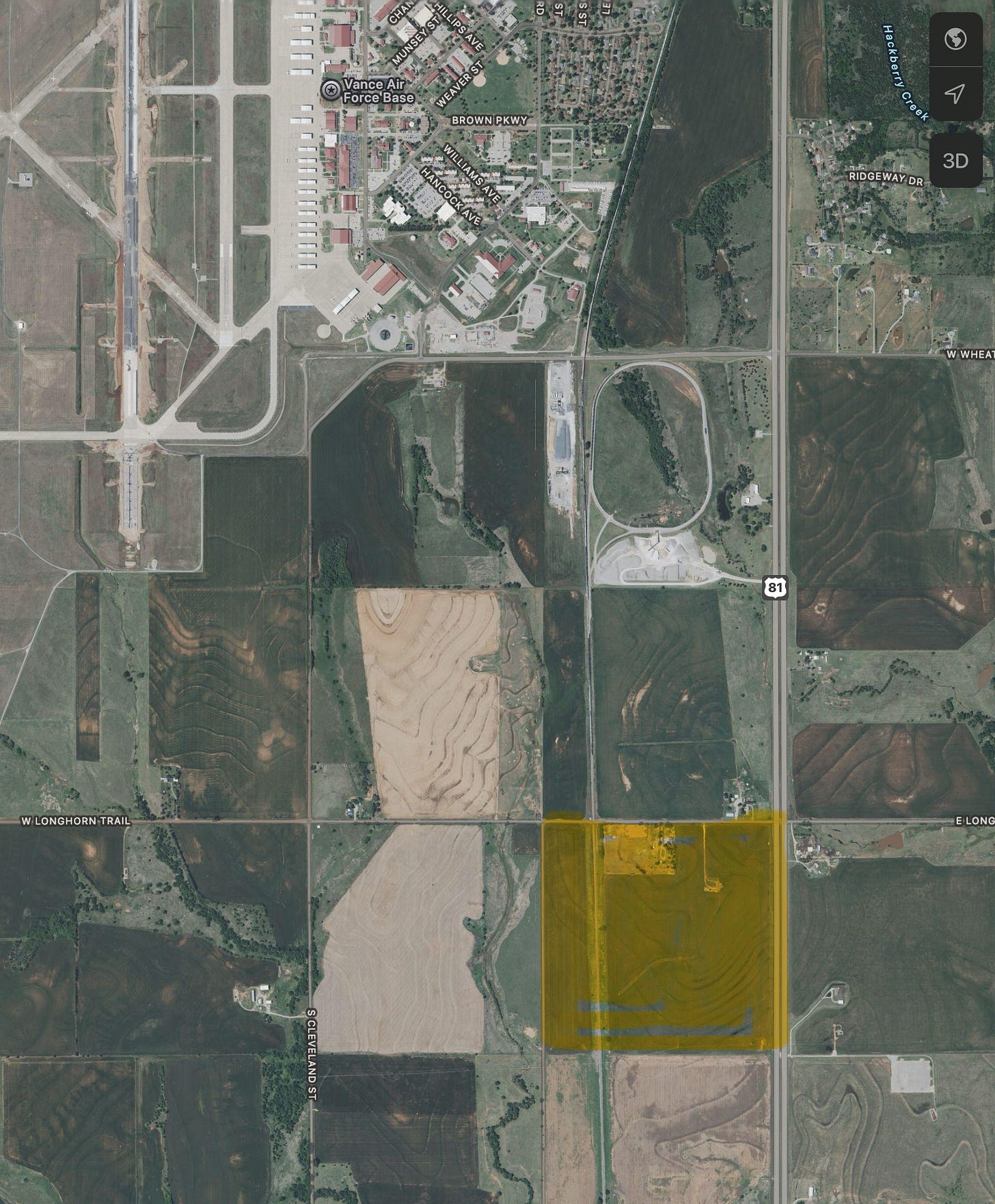
The photo below shows the family outside their home around 1897 or 98. I believe Mattie is the woman wearing a hat (second from left). Her sisters, Alberta and Almeda flank her on each side, while her youngest sister Mae stands to the left of her father (hand on chair). The two youngest boys are the shared children of Henry and Eliza (both sitting), Allie (standing left of Mae), and Olten (between Henry and Eliza). I believe the woman standing behind Eliza is Arvilla Kipp, Eliza’s daughter from her previous marriage.
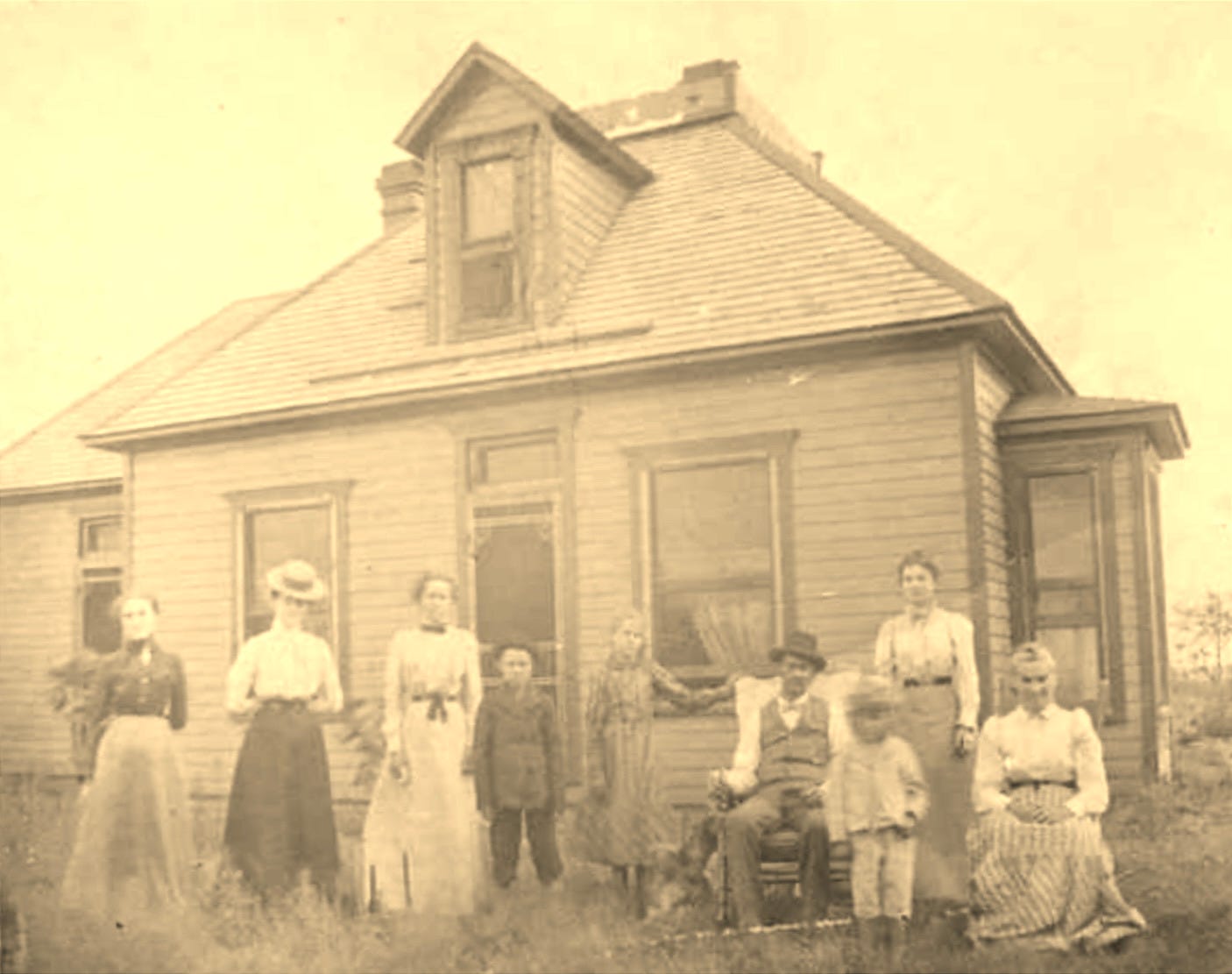
As reported by cousin Susan, whose grandmother was Almeda (Mattie’s sister), the Cook girls “boarded out” to schools as soon as they could to get away from home.
Both Mattie and Almeda attended Fairmount Academy in Wichita, KS, which was operated as part of Fairmount College. Originally known as a “Young Ladies' College”, the school admitted young women twelve years of age and older who were "able to read, write, spell and recite the parts of speech." By the late 1890s, the College was also admitting some men.
In my research, I found several newspaper items noting both Mattie and Almeda attended Fairmount. Many of these also noted the attendance of Blanche Houston, a classmate and close friend. From ancestry records, I was surprised to discover that Blanche would become both girls’ sister-in-law, when she married their older brother John Percival Cook (1876-1965) in August 1903. Almeda and Blanche would go on to also earn their Bachelor degrees at Fairmount, while Mattie would pursue other university opportunities.
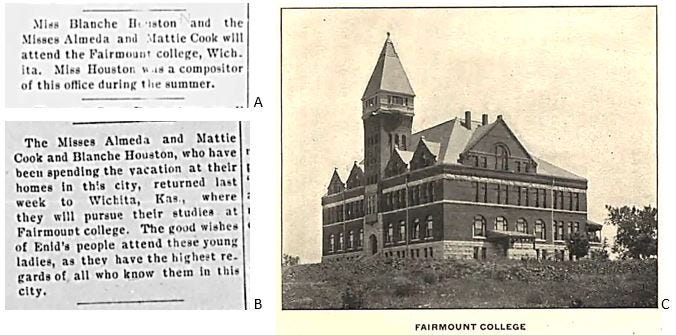
While attending Fairmount the girls boarded at Holyoke Cottage, a large home that served as the women’s dormitory. Almeda in her last few years at Fairmount would rent on the third floor of a home owned by the college’s first Dean, W.H. Isely. Here she met her future spouse, Charles Christian Isely, W.H.’s younger brother. Today the college is known as Wichita State University. Unfortunately, Fairmount Hall burned down in the 1920s, but Holyoke Cottage is still standing.
Here are a few photos of college life in 1899 and 1900, during the time that the two Cook sisters and future sister-in-law attended. Select each image to view the complete photo.


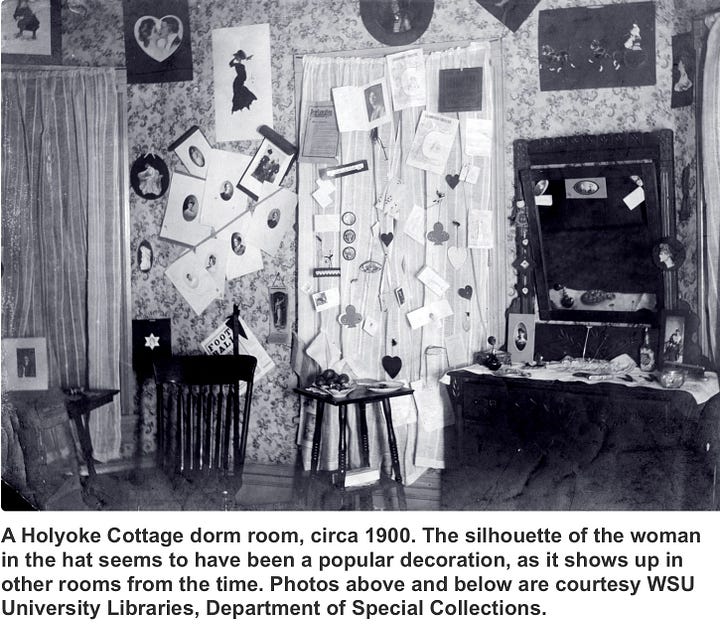


Music and socializing were favorite activities of the Cook sisters when Mattie and Almeda were home from school. From the number of social items that I discovered in the archived Enid, OK newspapers, it seems that their talents were frequently tapped for church events, community socials, friend’s gatherings and weddings, and even visiting scholar lectures. The newspaper items below represent a sampling of events to which Mattie and her sisters lent their musical talents.

This photo, among the several that were shared by Susan, is one of my favorites. Taken around 1900 in the family’s parlor, it shows Albertha and Almeda on the guitars while Mattie holds a songbook. The original photo had been damaged by scribble marks. But thanks to the graphic artist talents of my daughter, Jessica, I have this cleaned-up version to share.
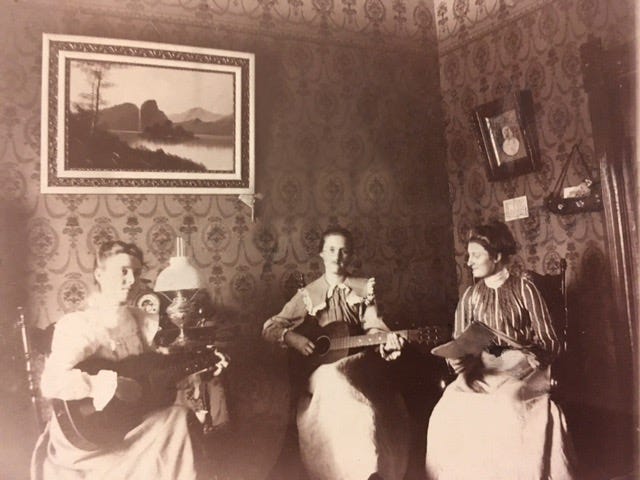
The Cook siblings were close, especially the sisters. The girls were also quite popular among Enid’s younger set and they were frequently involved in the planning of social activities. This photo below (also shared by distant cousin Susan) was labeled a “family picnic.” But, in my research I found a small news item about a lavish picnic that Mattie had helped plan. Since most of the individuals in the photo looked to be a similar age, I can’t help but wonder if this photo isn’t the “Diver’s Grove picnic” noted in the article (see below).
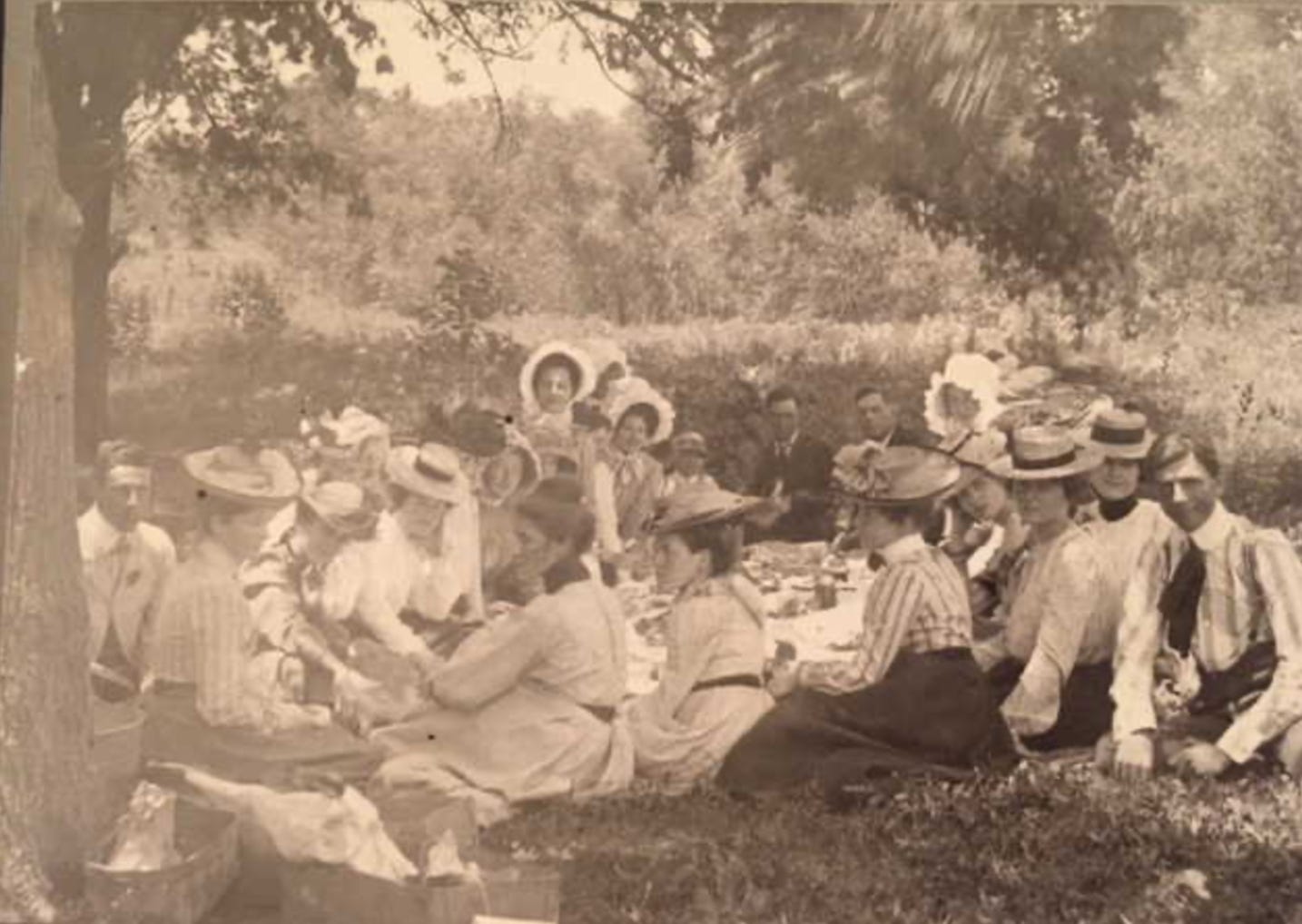
After completing her education at Fairmount College it seems that Mattie spent at least one semester (if not a year) at Fort Worth University in Texas. The University was affiliated with the Methodist Episcopal Church and operated from 1881 to 1911. When it dissolved in 1911, it became part of the Methodist University of Oklahoma (now Oklahoma City University). This affiliation between the two schools is how I believe Mattie may have originally become aware of Texas University. In 1903, these two news items appeared in the Enid local paper noting her attendance.
After the winter of 1903, I could find no more mention of Mattie’s attendance at the university. This leads me to believe that she returned home only after one semester. And since it’s already well documented in my chapter on the Green Family: Lawton Years that she married Timothy Green the following year in 1904, I suspect her time in Texas may have been even more short-lived.
In closing out this chapter, I can share one last photo of the five Cook family siblings. I am indebted to Susan for her generosity in sharing the family history that she could.
As for the destiny of the 5 siblings, here are a few highlights:
John Percival would marry Blanche Houston (Mattie & Almeda’s Fairmount College classmate) and would go onto become a successful banker and have one son.
Almeda, as already covered in this chapter, would marry Charles Christian Isely. Together they would raise six children, while living in Dodge City, Kansas.
Mattie would meet and marry Timothy Green and settle in Lawton, O.T. Together they would have two boys. Clarence Douglas Green (my grandfather) and Robert Oscar Green.
Albertha would marry Andrew Larson and raise six children while remaining in Oklahoma.
Mae, after moving out the house and living for a while with her older sister Almeda and husband would meet and marry Lester Luther and raise three children. She would live out her life in Oklahoma and Kansas.
Of all the Cook children, Mattie would be the only one to not live to see retirement and old age. The majority of the Cook children lived into their 80s, except for Mae and Mattie. Mae however would not die until the age of 68. Mattie died first of all her siblings at just 35. She fell ill and died of the Spanish Flu epidemic in 1919. Mattie’s death was deeply felt by her siblings, but especially by Almeda, who was had acted as surrogate mother to her younger siblings. You can find the rest of Mattie’s story at the Green Family; The Lawton Years.
Lastly, Henry Albert Cook, the siblings father, died in 1907. In my research, I’ve uncovered a lot more to share about Henry. He was an astute and an ambitious business, that some might call a “wheeler-dealer.” So stay tune. I’ll definitely have another chapter to share about H.A. Cook with more stories in the not-so-distant future.

Addendum June 2025:
Thornton-Cook family marriages
In my genealogy research I have now come across three marriages between siblings of the Cook family and siblings of the Thornton family. Three Thornton siblings married three Cook siblings. The families both lived in Sanilac County, migrating from somewhere in Canada in the 1860s. My 2x great-grandparents were the first among the three sets of marriages that occurred between the two families. Here are the family members and marriage dates:
Henry Albert Cook (1850-1907) married Sarah Elizabeth Thornton (1850-1890) on April 18, 1875. These are my 2x great-grandparents.
John Wade Thornton (1853-1928) married Maria Eleanor Cook (1856-1946) on September 28, 1878
Charles Thomas Thornton (1856-1928) married Louella Lavina Cook (1864-1896) on January 5, 1880
Talk about sibling marriages and “double cousins.”
July 2025:
This thrilled marriage between the Cook and Thornton families was confirmed in the recent finding while visiting my Aunt Jen. Among her family photos was this hand written piece of paper, noting the three marriages:



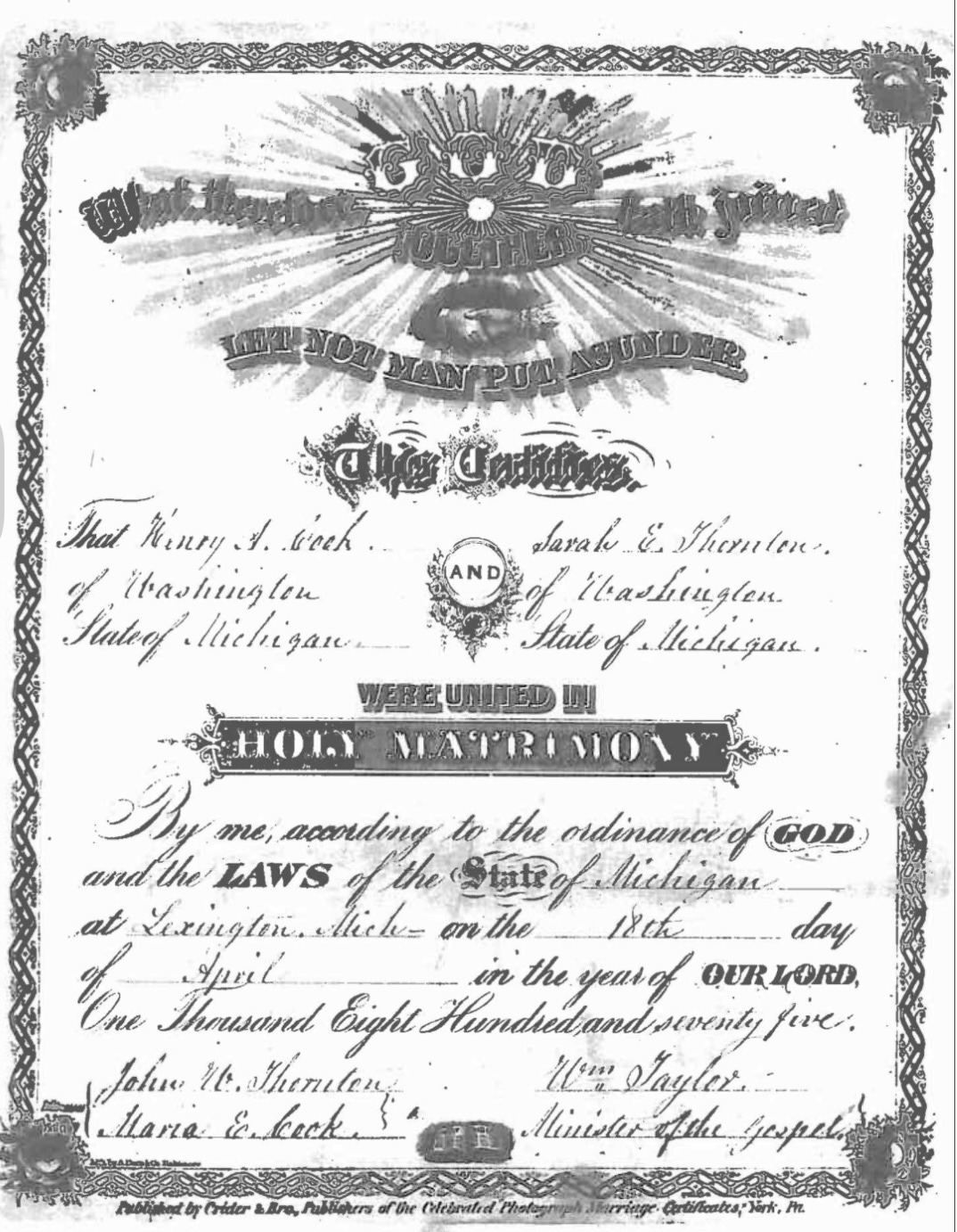





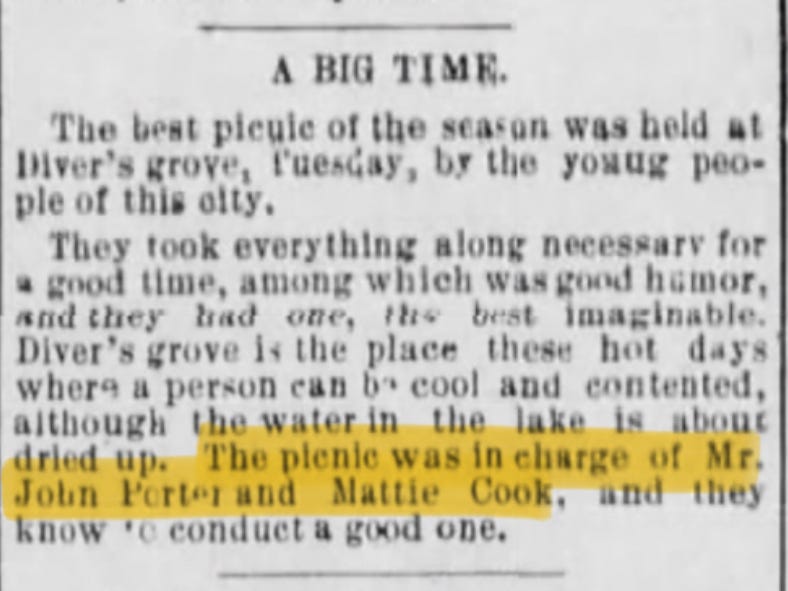

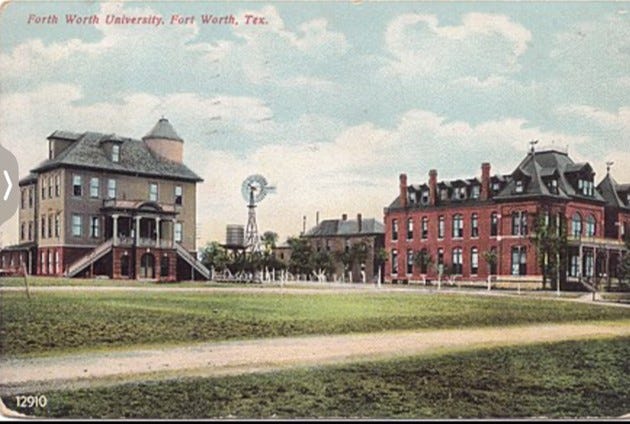


I liked the structure for this piece. You dive right in to the goodies, get the readers attention and then back track a bit to cover the necessary preliminary connections. Well done. Your intuition about the true purpose of the family photo appeals to me as well. With the invention of the the Carte de visite' process after the Civil War, one photo could be printed multiple times so for a man in this situation or a single person could affordably get multiple photos of themselves to distribute to friends and family as a sort of "advertising." Hey they didn't have E Harmony!
Finding a genealogy-minded cousin who is as excited and passionate as we are to share and build upon each others knowledge is a true gift, don’t you think?!